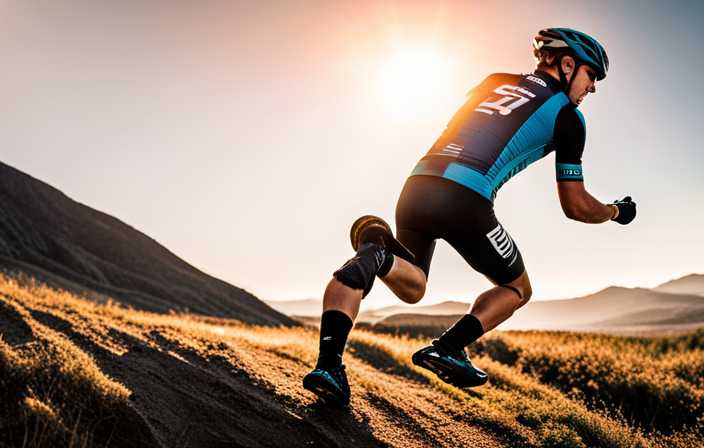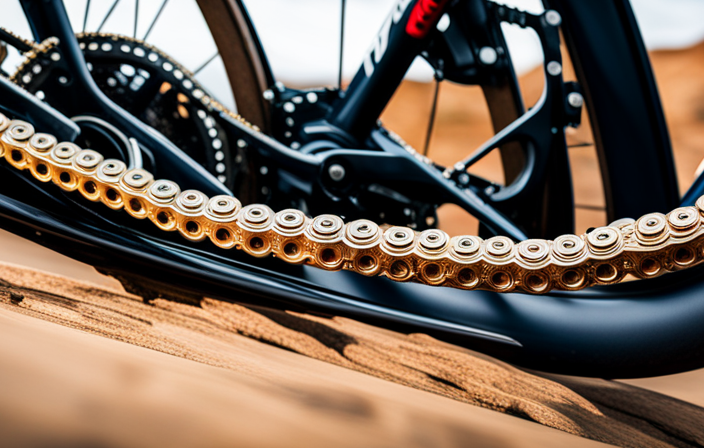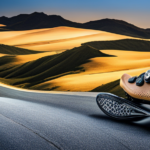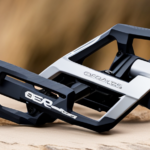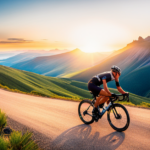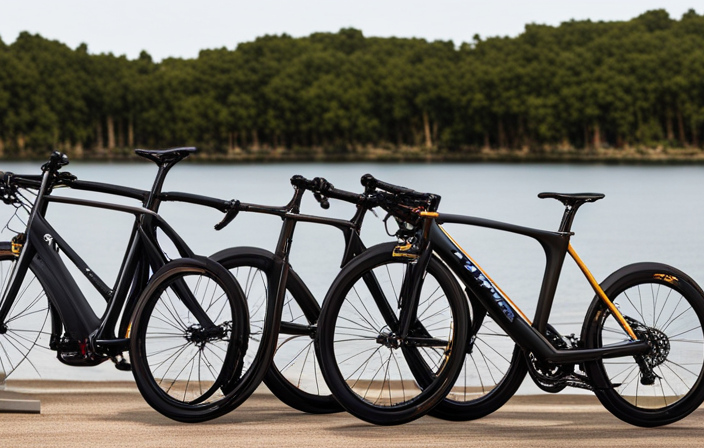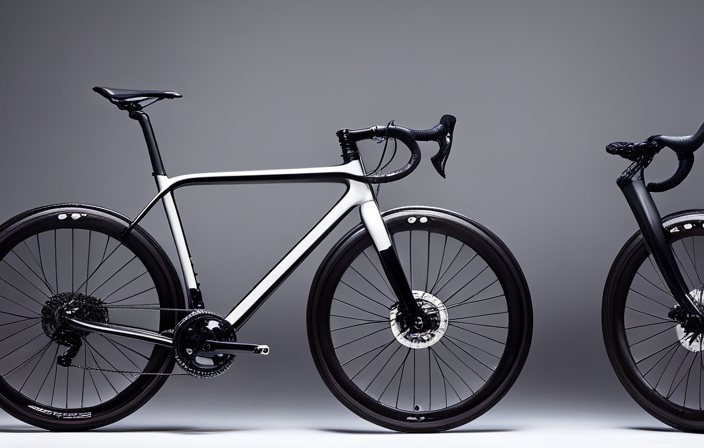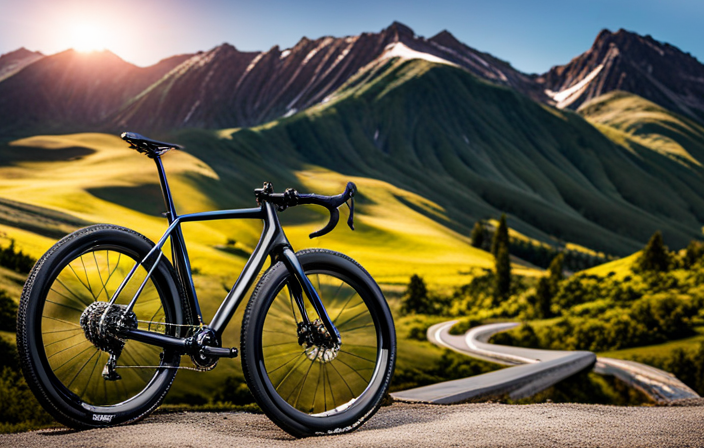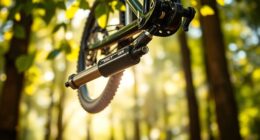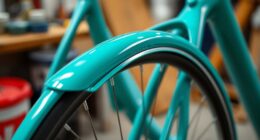As a fellow gravel biker, I am well aware of how essential it is to wear the appropriate shoes to truly elevate your gravel biking experience.
In this article, I will provide you with valuable insights on what kind of shoes are best suited for gravel biking. Whether it’s considering the terrain, choosing shoes with stiff soles for efficient pedaling, or looking for toe protection and reflective details for safety and visibility, I’ll cover all the essential factors to help you find the perfect pair of shoes for your next gravel ride.
Key Takeaways
- Proper footwear enhances gravel biking experience
- Choose shoes with stiff soles for efficient pedaling
- Look for shoes with good traction for off-road riding
- Opt for shoes with toe protection for safety
Importance of Proper Footwear for Gravel Biking
You need to make sure you’re wearing the right shoes for gravel biking. Having proper footwear is essential for a successful and enjoyable ride.
One important factor to consider is the type of pedal system you use. Gravel bikers often opt for clipless pedals, which offer several benefits. These pedals allow you to connect your shoes directly to the pedals, providing a secure and efficient power transfer. This connection ensures that your feet stay firmly planted on the pedals, preventing any slipping or loss of control.
There are different types of pedal systems available for gravel biking, such as two-bolt and three-bolt cleats. Two-bolt cleats are commonly used in mountain biking and provide more flexibility when walking off the bike. On the other hand, three-bolt cleats offer a wider platform and increased stability during pedaling.
Considering the terrain and your riding style is also crucial when choosing the right shoes for gravel biking. If you’ll be tackling rough terrains with loose gravel, it’s recommended to opt for shoes with aggressive tread patterns that provide excellent grip on uneven surfaces. Additionally, if you prefer a more casual riding style, there are hybrid cycling shoes available that offer a balance between comfort and performance.
Now let’s delve into why it’s important to consider these factors when selecting your footwear for gravel biking…
Consider the Terrain and Riding Style
When choosing footwear for riding on gravel, it’s essential to consider the terrain and your preferred style of riding. Here are three key factors to keep in mind:
-
Terrain: Gravel biking can take you through a variety of surfaces, including loose gravel, rough trails, and even pavement. It’s important to choose shoes that offer adequate traction and stability for these different terrains. Look for shoes with a grippy outsole that can handle the challenges presented by gravel roads.
-
Riding Style: Your personal riding style will also influence the type of shoes you should wear. If you prefer a more aggressive approach and enjoy tackling technical sections, consider mountain bike-style shoes with added ankle protection and enhanced durability. On the other hand, if you’re more focused on long-distance rides and comfort is a priority, opt for shoes with a balance of stiffness for efficient pedaling and cushioning for all-day comfort.
-
Benefits of Clipless Pedals: Consider investing in clipless pedals and compatible cycling shoes. These systems provide increased power transfer, as they allow you to effectively pull up on the pedals during each stroke. This can be particularly advantageous when climbing steep sections or accelerating quickly.
To maximize your pedaling efficiency on gravel roads, it’s important to choose shoes with stiff soles that minimize flexing while pedaling. This ensures that all your energy is efficiently transferred into forward motion without any wasted effort or discomfort.
Choose Shoes with Stiff Soles for Efficient Pedaling
Consider opting for cycling footwear with stiff soles to enhance pedal efficiency on gravel roads. When it comes to riding a gravel bike, having shoes with the right level of stiffness is crucial. The sole of a cycling shoe plays a significant role in power transfer from your feet to the pedals, and stiff soles are designed to minimize energy loss by providing a solid platform for efficient pedaling.
To understand the importance of flexibility in shoe soles, let’s take a look at the following table:
| Shoe Flexibility | Benefits |
|---|---|
| Stiff | – Improved power transfer – Reduced fatigue – Enhanced pedaling efficiency |
| Moderate | – Better comfort – Increased flexibility off the bike |
| Flexible | – Greater walking comfort – Easier off-bike maneuverability |
Proper shoe sizing is also essential for optimal performance and comfort while riding. Ill-fitting shoes can lead to discomfort, hot spots, or even numbness during long rides. Make sure you measure your feet accurately and choose shoes that provide enough room for your toes without being too loose.
With proper shoe sizing and stiff soles, you’ll be able to maximize your pedal stroke efficiency on gravel roads. In the next section, we will discuss why it’s important to look for shoes with good traction for off-road riding without compromising other factors such as comfort and durability.
Look for Shoes with Good Traction for Off-Road Riding
Finding footwear with good traction is crucial for off-road riding to ensure stability and control. When it comes to off-road cycling, having shoes with excellent grip can make a world of difference in terms of safety and performance. Here are four key factors to consider when looking for shoes with good traction:
-
Lug pattern: Look for shoes with deep, aggressive lugs that provide maximum grip on loose gravel, mud, or slippery surfaces. These lugs help dig into the terrain and prevent slippage.
-
Rubber compound: Opt for shoes made from sticky rubber compounds that offer superior traction. This type of rubber provides better adherence to various surfaces encountered while riding off-road.
-
Outsole flexibility: Shoes with a slightly flexible outsole allow the lugs to conform to the ground, enhancing grip and overall stability.
-
Tread design: A well-designed tread pattern helps channel away mud and debris, maintaining contact between the shoe’s sole and the ground.
Ensuring your bike shoes have good traction is essential for off-road safety. With proper footwear, you’ll be able to confidently tackle challenging terrains without worrying about losing control or slipping unexpectedly.
Transitioning into the subsequent section about toe protection, it’s also important to consider other safety aspects when choosing your gravel biking shoes.
Opt for Shoes with Toe Protection for Safety
To ensure your safety while off-road riding, make sure you choose footwear that offers toe protection. When riding on gravel or rough terrain, there is always a risk of stubbing your toes against rocks, roots, or other obstacles. Having shoes with toe protection will help prevent potential injuries and keep you safe during your rides.
When selecting shoes for gravel biking, it’s important to consider the importance of toe protection. Look for shoes that have reinforced toe boxes or rubber bumpers at the front. These features provide an extra layer of defense against impacts and abrasions.
Additionally, it’s crucial to opt for shoes made from breathable materials. Off-road riding can be physically demanding and can cause your feet to sweat. Shoes with good breathability will allow air circulation and prevent moisture buildup, keeping your feet dry and comfortable throughout your rides.
To emphasize the significance of toe protection in choosing the right footwear for gravel biking, take a look at this table:
| Shoe Feature | Benefits |
|---|---|
| Reinforced Toe Box | Protects toes from impacts and abrasions |
| Rubber Bumpers | Provides additional defense |
| Breathable Materials | Prevents moisture buildup |
Considering these factors when selecting your gravel biking shoes will enhance your overall riding experience. Now let’s explore another important aspect: considering the closure system for a secure fit…
Consider the Closure System for a Secure Fit
Ensuring a secure fit is crucial when choosing footwear for off-road riding. The closure system of your shoes plays a significant role in providing the necessary stability and support during gravel biking adventures. There are various closure systems available for road cycling shoes, but one option that stands out is lace-up closures.
Here are three benefits of lace-up closures that will surely evoke emotion in you:
-
Customizable Fit: Lace-up closures allow you to adjust the tightness according to your preference, ensuring a snug and secure fit. This customizable feature helps prevent any discomfort or unwanted movement while pedaling through rough terrains.
-
Even Pressure Distribution: The laces distribute pressure evenly across your foot, minimizing hot spots or pressure points that can lead to pain or numbness during long rides.
-
Easy Adjustability: Unlike other closure systems, lace-ups enable quick and easy adjustments on the go without needing any additional tools.
When looking for shoes with breathable materials for comfort, it’s important to consider not only the closure system but also the overall construction and design. Breathable materials such as mesh panels or perforations allow air circulation, keeping your feet cool and dry throughout your gravel bike adventures.
Transitioning into the subsequent section about ‘look for shoes with breathable materials for comfort,’ it’s essential to prioritize finding footwear that provides both a secure fit and adequate breathability for an enjoyable ride experience.
Look for Shoes with Breathable Materials for Comfort
After considering the closure system for a secure fit, let’s now shift our attention to another important aspect when choosing shoes for gravel biking: the materials used and their breathability. When embarking on long rides or challenging terrains, it is crucial to prioritize comfort. This is where breathable materials come into play.
Breathable materials in cycling shoes allow air circulation around your feet, preventing excessive sweating and discomfort. They help regulate temperature, keeping your feet cool and dry throughout your ride. This feature becomes even more important when riding in warm weather or during intense workouts.
Additionally, it’s worth mentioning that some gravel bike adventures may involve encounters with wet conditions like rain or puddles. In such cases, having waterproof or water-resistant shoes can significantly enhance your overall experience. These features provide protection against moisture penetration, ensuring that your feet stay dry and comfortable even in damp environments.
Transitioning smoothly into the next section about waterproof or water-resistant shoes for wet conditions, it is essential to consider this factor as well when selecting the ideal footwear for gravel biking adventures.
Consider Waterproof or Water-Resistant Shoes for Wet Conditions
When riding in wet conditions, it’s important to think about having shoes that are waterproof or water-resistant to keep your feet dry and comfortable. Waterproof shoes are designed to completely prevent water from entering, while water-resistant shoes can repel water to some extent but may not offer the same level of protection as waterproof ones.
Here are the benefits of waterproof shoes:
-
Complete Protection: Waterproof shoes create a barrier that prevents any moisture from seeping through. This is especially beneficial when riding on gravel roads where puddles and mud are common.
-
Comfortable Feet: By keeping your feet dry, waterproof shoes help maintain a comfortable temperature inside. Wet feet can lead to discomfort, blisters, and even cold-related issues in extreme conditions.
-
Durability: Waterproof materials used in these shoes are often more durable than those used in regular footwear. They can withstand exposure to water and provide long-lasting performance.
Transitioning into the next section about choosing shoes with ample cushioning for long rides, it’s also essential to consider comfort during extended periods on the bike.
Choose Shoes with Ample Cushioning for Long Rides
It’s important to prioritize comfort on long rides, so make sure to choose shoes with plenty of cushioning. When it comes to gravel biking, having the right footwear is crucial for a comfortable and enjoyable experience. One key aspect to consider is the importance of proper footwear for comfort.
Long rides can put a lot of strain on your feet, so having shoes that provide ample cushioning will help absorb shocks and reduce fatigue.
When selecting shoes for gravel biking, look for ones that have shock absorption features. These shoes are designed to minimize the impact of rough terrains and uneven surfaces, ensuring a smoother ride. They typically have extra padding in the midsole or heel area, providing additional support and cushioning.
Having adequate cushioning in your shoes can make a significant difference in how your feet feel during and after long rides. It helps reduce pressure points and minimizes discomfort caused by prolonged pedaling on rough surfaces.
As you transition into the subsequent section about checking for proper ankle support to prevent injuries, remember that finding the right footwear is just one aspect of ensuring a comfortable and safe ride.
Now let’s discuss another crucial factor: checking for proper ankle support to prevent injuries.
Check for Proper Ankle Support to Prevent Injuries
When choosing shoes for long rides on a gravel bike, it is important to consider not only ample cushioning but also proper ankle support to prevent injuries. Ankle stability is crucial when riding on uneven terrain, as it helps maintain balance and reduces the risk of sprains or strains.
To ensure optimal ankle support, look for shoes that have a high-top design or include features such as ankle straps or lace-up systems that can be tightened securely around the ankle. These elements provide added stability and help prevent your foot from rolling inward or outward during pedaling.
Proper ankle support goes hand in hand with injury prevention. By keeping your ankles stable, you reduce the chances of experiencing overuse injuries like tendonitis or stress fractures. Additionally, having good ankle support allows you to pedal more efficiently and transfer power effectively to the pedals.
Consider shoes with compatibility for cleats or pedal systems as this will allow you to engage with your bike’s pedals more securely, enhancing both comfort and performance.
Now let’s move on to discussing why it’s important to consider shoes with compatibility for cleats or pedal systems…
Consider Shoes with Compatibility for Cleats or Pedal Systems
To enhance your riding experience, make sure to choose shoes that are compatible with cleats or pedal systems. When considering the type of shoes for a gravel bike, it is important to take into account the terrain you will be riding on and the pedal system you will be using.
Gravel biking often involves traversing various types of terrain, such as loose gravel, dirt trails, and rocky surfaces. Therefore, it is crucial to have shoes that provide excellent grip and stability. Look for shoes with a durable outsole that offers traction on different surfaces.
Additionally, consider the compatibility of the shoes with cleats or pedal systems. Cleats are small metal or plastic devices that attach to the bottom of cycling shoes and clip into pedals, providing a secure connection between your feet and the bike. Different pedal systems require specific types of cleats, so ensure that your chosen shoe can accommodate your preferred system.
With proper terrain considerations and pedal system compatibility in mind, you can find the right pair of shoes for your gravel biking adventures.
In the next section about ‘look for shoes with reflective details for visibility,’ we’ll explore another essential aspect to consider when choosing gravel biking footwear: visibility on the road or trail at night or in low-light conditions.
Look for Shoes with Reflective Details for Visibility
When considering shoes for gravel biking, it’s important to think about safety as well. That’s why the next subtopic is all about looking for shoes with reflective details for visibility. Reflective shoe options are a great choice because they enhance your visibility on the road, especially during low-light conditions or at night. These shoes have reflective elements strategically placed on different parts of the shoe, such as the heel or sides, which catch and reflect light from various angles.
To help you understand the benefits of reflective accessories in shoes, let’s take a look at the following table:
| Benefits of Reflective Shoe Options |
|---|
| Enhanced visibility |
| Increased safety |
| Reduced risk of accidents |
| Peace of mind |
By wearing shoes with reflective details, you significantly improve your chances of being seen by other road users, reducing the risk of accidents and increasing overall safety. It offers peace of mind knowing that you’re doing everything possible to stay visible while enjoying your gravel biking adventures.
Now that we’ve covered the importance of reflective shoe options, let’s transition into our next section: considering the weight of the shoes for performance.
Consider the Weight of the Shoes for Performance
If you want to improve your performance, it’s important to consider the weight of your footwear. When it comes to gravel biking, finding the right balance between weight and comfort is crucial.
Here are four key factors to consider when evaluating the impact of shoe weight on power output:
-
Power transfer: Lightweight shoes can enhance power transfer by minimizing energy loss through unnecessary movements. This allows for a more efficient pedal stroke and ultimately boosts your overall performance.
-
Efficiency: Lighter shoes reduce rotational inertia, making it easier to accelerate and maintain speed on varying terrains. This can make a significant difference in long rides or races where every bit of energy conservation matters.
-
Comfort: While lighter shoes may offer better power output, comfort should not be compromised. Look for models that provide adequate cushioning and support without adding unnecessary bulk.
-
Durability: Although weight is an important consideration, durability is equally vital for long-term use. Opt for shoes made from high-quality materials that can withstand the rigors of gravel riding.
Considering these factors will help you find the perfect balance between shoe weight and performance gains.
Now let’s check for durability and longevity of the shoes in order to ensure a wise investment in your gear without compromising on quality or functionality.
Check for Durability and Longevity of the Shoes
Consider evaluating the durability and longevity of your footwear to ensure a wise investment in gear that will last. When it comes to gravel biking, durability is essential because these shoes are subjected to rough terrains and unpredictable weather conditions. While comfort is important, it should not be compromised at the expense of durability. Look for shoes made from high-quality materials that can withstand the demands of gravel riding.
Durability vs. comfort is a common dilemma when choosing gravel bike shoes. You want a shoe that will provide both protection and comfort during long rides. It’s important to find a balance between the two, as sacrificing one for the other may lead to discomfort or premature wear and tear. Consider features like reinforced toe caps, sturdy outsoles, and durable uppers that can withstand abrasion and impact.
Price vs. quality is another factor to consider when selecting gravel bike shoes. While it may be tempting to opt for cheaper options, investing in higher-quality shoes often pays off in the long run. Cheaper shoes may not offer the same level of durability and performance as more expensive ones.
When evaluating the durability and longevity of different shoe options, consider reading reviews from other gravel bikers who have tested them extensively. These real-life experiences can provide valuable insights into how well a particular shoe holds up over time.
In conclusion, when looking for gravel bike shoes, prioritize durability while considering comfort and price versus quality trade-offs. Remember to try on different brands and models to find the perfect fit before making your final decision on which pair of shoes will accompany you on your adventures ahead.
Try on Different Brands and Models to Find the Perfect Fit
When it comes to finding the perfect shoes for your gravel bike adventures, durability and longevity are crucial factors to consider. However, even if you find a pair of shoes that meet these criteria, they won’t be suitable if they don’t fit properly. That’s why trying on different brands and models is essential in finding the right shoe size for your feet.
To help you in this process, I’ve created a table below with two columns and three rows that showcases some popular brands and models known for their quality craftsmanship and comfort:
| Brand | Model |
|---|---|
| Shimano | SH-XC5 |
| Giro | Privateer R |
| Specialized | Recon 3.0 |
Not only will trying on different shoes allow you to determine the best fit, but it also gives you the opportunity to assess their overall comfort. Remember to walk around in them and mimic cycling motions to get a better sense of how they’ll perform during your rides.
Additionally, while considering the cost and budget is important when shopping for gravel bike shoes, prioritize finding a pair that meets all your needs first. It’s worth investing in a reliable pair of shoes that will provide both comfort and performance on your gravel bike journeys.
Frequently Asked Questions
Are there any specific closure systems that are recommended for gravel biking shoes?
When it comes to closure systems for gravel biking shoes, there are a few options to consider.
The most popular choices include traditional laces, Velcro straps, and BOA dials. Each system has its advantages and disadvantages.
Laces offer a customizable fit but can be time-consuming to adjust on the go.
Velcro straps provide quick and easy adjustments but may not offer as precise of a fit.
BOA dials offer micro-adjustments with a turn of a dial but can be more expensive.
As for the best shoe brands for gravel biking, some top contenders include Shimano, Giro, Specialized, and Pearl Izumi.
What are some examples of breathable materials that are commonly used in gravel biking shoes?
Breathable materials are essential for comfort and moisture management in gravel biking shoes. Some popular options for these materials include mesh, synthetic fabrics, and perforated leather.
Mesh is a lightweight material that provides excellent breathability. However, it may lack durability compared to other options.
Synthetic fabrics offer a balance of breathability and durability. They are a popular choice for gravel biking shoes.
Perforated leather combines breathability with a more stylish appearance. It offers good ventilation while also looking great on the bike.
When it comes to shoe soles, there are different types to consider. Rubber soles provide good grip on various surfaces but can be heavy. Carbon fiber soles, on the other hand, are lightweight and stiff, allowing for efficient power transfer. However, they may not offer the same level of traction as rubber soles.
Some popular gravel biking shoe brands and models include the Giro Privateer Lace, Pearl Izumi X-Project P.R.O., and Specialized Recon 2.0. These shoes offer a combination of comfort, breathability, and performance for gravel biking enthusiasts.
Can you provide some tips on how to properly check for ankle support in gravel biking shoes?
To ensure optimal ankle support in gravel biking shoes, there are a few key tips to keep in mind.
First, prioritize proper shoe fit as it plays a vital role in preventing ankle injuries. Look for shoes with a secure closure system and adjustable straps that allow you to customize the fit around your ankle.
Additionally, consider shoes with a higher cut or built-in ankle protection for added stability.
Remember, investing in well-fitting shoes is crucial for maintaining ankle stability during gravel biking adventures.
What are the advantages of choosing shoes with cleat or pedal system compatibility?
When it comes to choosing shoes for gravel biking, one of the key considerations is whether they are compatible with a cleat or pedal system. The advantages of opting for shoes with this compatibility are numerous.
Firstly, they provide a secure connection between your foot and the pedal, allowing for efficient power transfer and improved pedaling technique. Additionally, they offer better control and stability while riding, especially on rough terrain.
However, it’s important to note that clipless pedals can take some time to get used to and may require additional equipment such as cleats.
How can reflective details on gravel biking shoes enhance visibility?
Reflective details on gravel biking shoes play a crucial role in enhancing visibility, especially during low light conditions or at night. They are strategically placed on the shoe’s upper or heel to reflect incoming light, making you more visible to motorists and other cyclists.
When choosing gravel biking shoes, it is essential to prioritize proper fit and comfort. Additionally, selecting the right sole stiffness is important as it affects power transfer and overall performance on various terrain types.
Conclusion
In conclusion, finding the right shoes for gravel biking is crucial for a successful and enjoyable ride. It’s like choosing a partner who understands your needs and supports you throughout your journey.
So, imagine strapping on a pair of shoes that feel like clouds on your feet, with soles as stiff as a board to give you maximum power transfer, and traction that grips onto the terrain like Velcro.
These shoes are not just for riding; they’re your trusty sidekicks in conquering any gravel adventure.
So go forth and find those perfect shoes that will take you places!
